Nitisols
Table of contents
-
Introduction
-
Parent material and environment
-
Regional Distribution
-
Definition
-
Genesis
-
Characteristics of Nitisols
a. Morphological characteristics
b. Physical characteristics
c. Chemical characteristics
d. Biological characteristics
-
Management and Use of Nitisols
1. Introduction
|
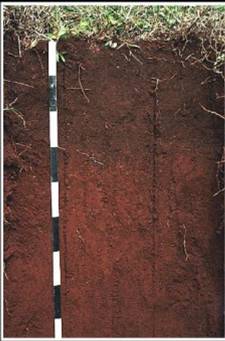 |
| Fig.1 Nitisol |
| (
Source: ISRIC, NL.) |
|
-
Nitisols are deep, well-drained red tropical soils with
diffuse horizon boundaries and a subsurface horizon with more than 30 % clay
and moderate to strong angular blocky structure elements that easily fall apart
into characteristic shiny, polyhedric (‘nutty’) elements.
-
Internationally known as:
-
Brazil = Terra roxa estruturada
-
Soil Taxonomy (USA) = kandic groups of Alfisols and
Ultisols
-
France = Sols fersialitiques
-
others: Red Earths
|
2. Parent material and environment
-
Parent material: finely textured
weathering products of intermediate to basic parent rocks, possibly rejuvenated
by recent admixtures of volcanic ash. The clay assemblage is dominated by
kaolinite. Nitisols are rich in Fe and have little water-dispersible (natural)
clay.
-
Environment: Nitisols are
predominantly found in level to hilly land under tropical rain forest or
savannah vegetation.
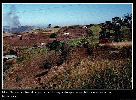 |
| Fig.2 Nitisols are found in gently undulating
landscapes |
| (
Source: FAO, 2001.) |
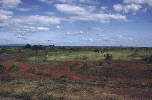 |
| Fig.3 Rhodic Nitisol landscape,
Nicaragua |
| (
Source: ISRIC, NL.) |
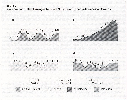 |
| Fig.4 a. undulating: on basic rock types and middle
slope positions b. volcanic landscape: mid-slope positions c. uplifted and
dissected landscapes on old surfaces: on slopes associated with
Ferralsols |
| (
Source: FAO, 2001.) |
3. Regional Distribution
 |
| Fig.5 Nitisols worldwide |
| (
Source: FAO, 2001.) |
-
Worldwide, about 200 Mio. hectares of Nitisols are found.
More than 50 % are found in Africa, mainly on uplands higher 1000 m: Ethiopia,
Kenya, Congo, Cameroon.
-
In Asia, S-America, C-America Nitisols are present at lower
altitudes.
4. Definition
5. Genesis
-
Ferralitization (early stage) see
(
 Process of
ferralitization) Process of
ferralitization)
-
Nitidization: formation of angular shiny peds, most likely
through
-
„micro-swelling and shrinking“
-
Shiny ped surfaces: combination of clay eluviation and
pressure when the soil is wet; clay particles orientate in well-regulated form
(ped face)
-
Homogenization: through
(
 termites)
, ants, earthworms
(Bioturbation) termites)
, ants, earthworms
(Bioturbation)
-
Assumption: rejuvenation through deposition/enrichment of
volcanic ashes
6. Characteristics of Nitisols
a. Morphological
characteristics
-
Nitisols are normally deeper than 150 cm and dusky red or
dark red in color.
 |
| Fig.7 Rhodic Nitisol, Nicaragua |
| (
Source: ISRIC, NL.) |
 |
| Fig.8 Nitisol, Rwanda |
| (
Source: ISRIC, NL.) |
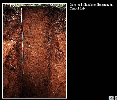 |
| Fig.9 Deep, red Nitisols on limestone in Central
Italy |
| (
Source: FAO, 2001.) |
-
They are well-drained soils with a clayey subsurface horizon
that is deeply strechted and has nutty or polyhedric blocky structure elements
with shiny ped faces.
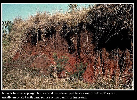 |
| Fig.10 Deep argic horizon |
| (
Source: FAO, 2001.) |
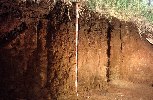 |
| Fig.11 Rhodic Nitisol with polyhedric blocky
structure elements, Nicaragua |
| (
Source: ISRIC, NL.) |
 |
| Fig.12 Rhodic Nitisol, Nicaragua with well
developed blocky soil structure |
| (
Source: ISRIC, NL.) |
 |
| Fig.13 Soil structure elements |
| (
Source: Brady and Weil, 2002.) |
-
Profile development mostly is ABtC.
-
The clay assemblage of Nitisols is dominated by kaolinite
with minor quantities of illite.
-
They contain 4 % or more ‘free’ iron
(Fe2O3, by dithionite-citrate
extraction) in the fine earth fraction and more than 0.2 % active or mobile Fe
(by acid oxalate extraction at pH 3).
b. Physical characteristics
-
Normally, they have a good soil structure, good porosity and
good water holding capacity and very good rootability.
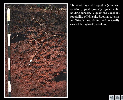 |
| Fig.14 Good physical properties |
| (
Source: FAO, 2001.) |
However, depending on their clay content they might
be hard when dry and sticky when wet.
c. Chemical characteristics
-
The CEC is higher compared to the other soils of the humid
tropics (Ferralsols, Lixisols, Acrisols) due to
-
the high clay content: higher than 30 % and sometimes
higher than 60 %. The BS varies between 10 to 90 %
 |
| Fig.15 Clay contents of Nitisols, ferralsols,
acrisols, lixisols and alisols |
| (
Source: Bridges, 1997.) |
-
Soil organic matter (SOM) makes a considerable
contribution to the overall CEC, especially in mollic or umbric soil units.
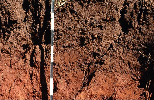 |
| Fig.16 Humic Nitisol, South
Africa |
| (
Source: ISRIC, NL.) |
d. Biological
characteristics
-
Intense faunal activity and termites are accountable for the
typical gradual horizon boundaries of Nitisols.
(
 Termites)
are particularly
effective in homogenizing soil. Termites)
are particularly
effective in homogenizing soil.
7. Management
-
Nitisols are among the most productive soils in the humid
tropics.
-
They are planted to plantation crops such as cocoa, coffee,
rubber, pineapple and are widely used for food crop production on
smallholdings.
-
In many volcanic areas: rejuvenation through volcanic
ash.
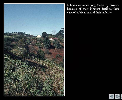 |
| Fig.17 Intercropping on Nitisols |
| (
Source: FAO, 2001.) |
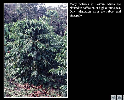 |
| Fig.18 Plantation crops |
| (
Source: FAO, 2001.) |
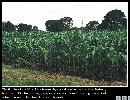 |
| Fig.19 Maize cropping on Nitisols |
| (
Source: FAO, 2001.) |
 |
| Fig.20 Maize-cassava intercropping on haplic Nitisol in
Rwanda |
| (
Source: ISRIC, NL.) |
|

 previous | next
previous | next

 previous | next
previous | next